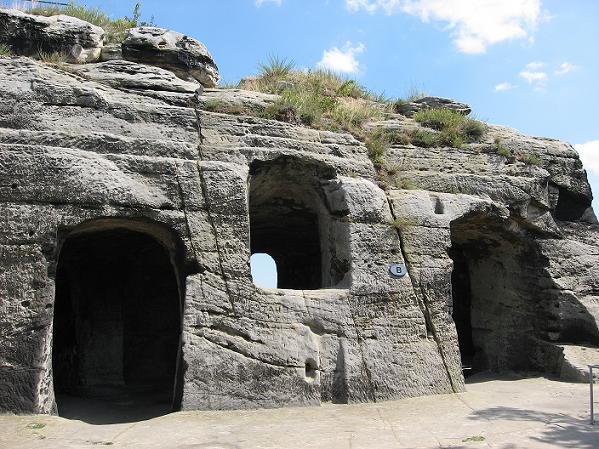14 Aug 2008
The Regenstein: the Time of Heinrich the Lion
Since the early 11th century, the Regenstein and its fellow triad castles Blankenburg and Heimburg (see this post) served to protect the ways to the palatine castles and towns of Quedlinburg, Goslar and Magdeburg, but also the ways to the iron and silver mines of the Harz.

Guard tower, based on a natural sandstone formation
(I call it that, because the platform on top provides a fine view in all directions)
The Counts of Regenstein were partisans and probably vassals (the feudal rights are not entirely clear*) of Heinrich the Lion during his quarrels with the Emperor Friedrich Barbarossa. Finally in 1180, the majority of the princes of the realm declared Heinrich, the most powerful rival among them, an outlaw. The emperor Friedrich Barbarossa distributed Heinrich's lands among some of the princes and then invaded Heinrich's Saxon possessions with an army to bring the rebel to task. Most of his allies abandoned Heinrich, and in 1181 he had to surrender at the diet of Erfurt and was condemned to exile.
* The Bishops of Halberstadt also claimed the overlordship.

One of the cliff promontories, seen from the curtain wall
The Count of Regenstein, either the aforementioned Konrad or his son, delivered the castle to Friedrich Barbarossa without resistance**, and was soon thereafter granted back the fief. In the following decades the family expanded the castle into a 100x175 square metres fortress with eight towers and about 200 metres curtain wall in addition to the natural cliffs. The St.Nicholas chapel dates from that time as well.
**An online source says the castle was destroyed, but I'm prone to believe the official guidebook, particularly since the fief seems to have been returned shortly after the surrender.

St.Nicholas Chapel, seen from the outside
(Added July 2015: This is another post in need of a rewirte. *sigh*)
Since the early 11th century, the Regenstein and its fellow triad castles Blankenburg and Heimburg (see this post) served to protect the ways to the palatine castles and towns of Quedlinburg, Goslar and Magdeburg, but also the ways to the iron and silver mines of the Harz.

(I call it that, because the platform on top provides a fine view in all directions)
The Counts of Regenstein were partisans and probably vassals (the feudal rights are not entirely clear*) of Heinrich the Lion during his quarrels with the Emperor Friedrich Barbarossa. Finally in 1180, the majority of the princes of the realm declared Heinrich, the most powerful rival among them, an outlaw. The emperor Friedrich Barbarossa distributed Heinrich's lands among some of the princes and then invaded Heinrich's Saxon possessions with an army to bring the rebel to task. Most of his allies abandoned Heinrich, and in 1181 he had to surrender at the diet of Erfurt and was condemned to exile.
* The Bishops of Halberstadt also claimed the overlordship.

The Count of Regenstein, either the aforementioned Konrad or his son, delivered the castle to Friedrich Barbarossa without resistance**, and was soon thereafter granted back the fief. In the following decades the family expanded the castle into a 100x175 square metres fortress with eight towers and about 200 metres curtain wall in addition to the natural cliffs. The St.Nicholas chapel dates from that time as well.
**An online source says the castle was destroyed, but I'm prone to believe the official guidebook, particularly since the fief seems to have been returned shortly after the surrender.

(Added July 2015: This is another post in need of a rewirte. *sigh*)
Comments:
<< Home
Fabulous pictures as ever! I love fortifications that use the natural rock. Even when where you can't, you get dressed-stone marvels of engineering, there's nothing to beat a good location.
By the way, when you say `decenniums' I wonder if the word you were after is `decades'?
By the way, when you say `decenniums' I wonder if the word you were after is `decades'?
Wow - that view to the forests below is stunning. That place looks better and better - I'm not surprised you found a plotbunny in there - I'm more surprised you didn't find an entire dynasty of them!
Lady D, it's at leat two. The place will feature in the Arminius novel as well (though without the Medieaval keep). And the view is stunning, esp. on a clear day.
Thank you, Bernita.
Thank you, Bernita.
Gabriele,
Those are cool pix.
They remind me a lot of Les Baux-de-Provence because both fortresses are carved from the mountainside. I'm not quite ready to do a full post about my travels to that medieval site yet, but did post a few pictures of Les Baux on my blog as well as a link to yours.
Post a Comment
Those are cool pix.
They remind me a lot of Les Baux-de-Provence because both fortresses are carved from the mountainside. I'm not quite ready to do a full post about my travels to that medieval site yet, but did post a few pictures of Les Baux on my blog as well as a link to yours.
<< Home


